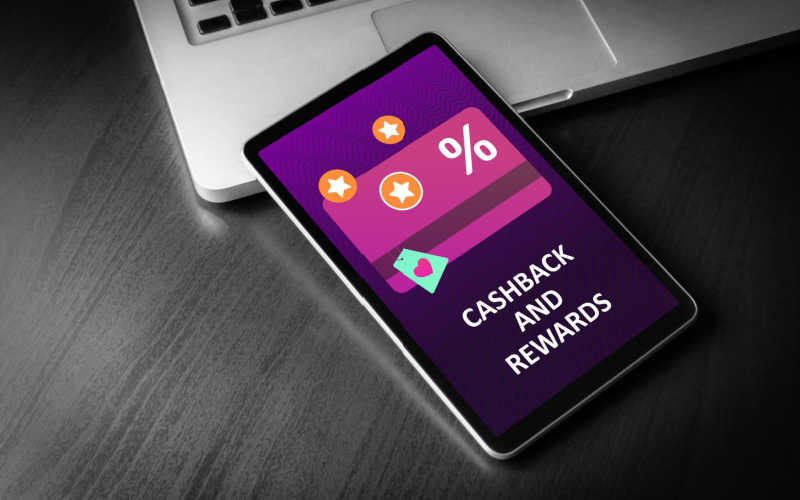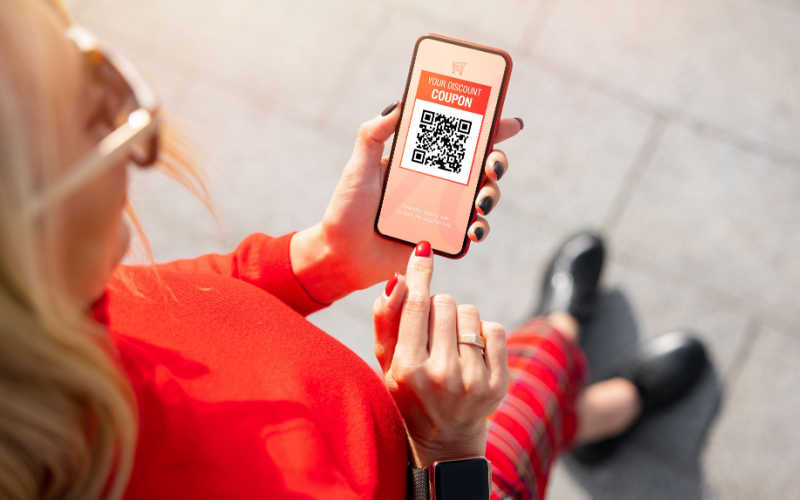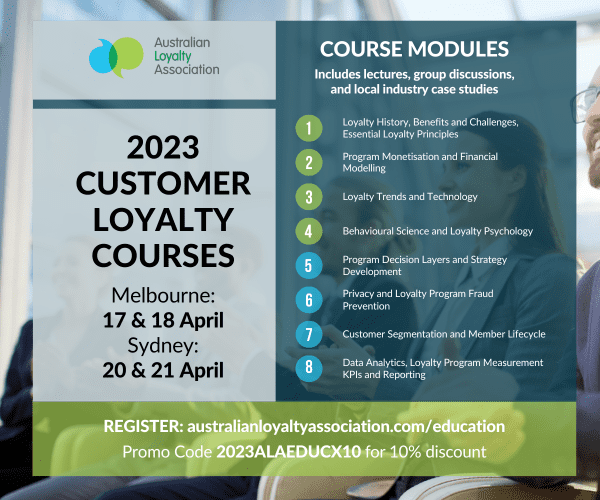Finding new ways to engage with customers and build long-term loyalty is central to the CX strategy of most businesses. A loyalty program that includes experiential rewards rather than a purely traditional points-based system can be an effective tool for building customer loyalty.
Building and maintaining customer loyalty before covid was a challenge. That challenge became more difficult because of the changes in consumer behaviour and the rapid shift to digital channels. Since the pandemic, many businesses, according to Sarah Richardson – Chair of the Australian Loyalty Association (ALA), have developed loyalty programs. She comments, “Loyalty programs are much more prevalent now than they were before Covid. Many businesses who didn’t have customer data to rely on, suffered greatly during the pandemic. Without customer data, it’s impossible to develop a deep understanding of customers and for many industries, you can’t collect customer data unless you have a loyalty program in place.”
Even though more businesses have loyalty programs in place, according to research by MIT, the number of customers who actively participate in them still sits at around 50%. This suggests that there’s something missing in most programs. Richardson highlights that the proliferation of loyalty programs has given consumers a lot of choices, “‘Customers have a lot more choice of which programs to be members of now and when there’s more choice, expectations invariably increase’”.
A key problem with most programs, highlighted by Forrester, is that most programs are ineffective in their communication and distinguishing the promotional messages and benefits members receive over non-members. Most consumers who belong to loyalty programs like to receive updates on their benefits. To be more engaging for members, brands should send relevant messages that include information about membership, recent purchases, and progress toward rewards redemption.
The initial investment in a loyalty program can be expensive depending on the scale and objectives of the program. It’s therefore important to get it right and to gain as much value from it as possible. Richardson comments, “Setting up a loyalty program can be expensive. If you are going to put in the effort in having staff and systems to reward loyalty customers, then it’s worth using it wherever you possibly can and getting the most value from it”.
Loyalty programs can be engines for growth!
The research from MIT found that companies that had a successful program in place experienced significant value and growth. It revealed that consumers who participate in the top-performing loyalty programs are 80% more likely to choose the brand over competitors and twice as likely to recommend the brand to others.
Richardson observes, “We see people in loyalty programs like Qantas Frequent Flyer or Velocity Frequent Flyer willing to spend up to 30% more on a flight, just so that they can keep their status with that program, and keep their points balances topped up”
So, despite the costs associated with having a loyalty program, and the lack of customer engagement associated with so many, a successful loyalty program can have a dramatic impact on customer loyalty and retention. This in turn means more profit, revenue, and growth.
So, what makes a loyalty program successful?
Loyalty programs need to offer better experiences
The rewards offered by a loyalty program need to go beyond the traditional points-based system and provide customers with unique, memorable experiences that create a deeper connection with the brand. Richardson advises, “With a loyalty program, there’s only so much you can give back in terms of rewards. So, some of the things you need to do will need to be more innovative and exciting for members. Experiential aspect like the actual experience of earning and redeeming points, and the online and app experience can make an enormous difference to a members experience and engagement with your program.“
Covid forced a number of brands to rethink their strategy around loyalty programs and what they offered members. “It was a really interesting period during covid. Loyalty programs like those offered by hotel chains, because no one was travelling, had to look at different ways members could earn and redeem rewards. That has affected consumers because now they have a lot more choices and ways they can earn and redeem points.”
The key to a successful loyalty program, according to Forrester, is offering rewards that are both desirable and unique and go beyond offering points. Experiential rewards can range from VIP access to events, exclusive behind-the-scenes tours, personalised consultations or experiences, and much more. Consider what your brand can offer that is truly special and relevant to your customers. For example, a luxury hotel could offer a private, guided tour of the local city or a cooking lesson with the hotel’s head chef.
Rather than offering discounts in exchange for points, these sorts of things add value and deliver unique experiences that generate an emotional connection between the customer and the brand. According to the 2022 ALA Annual Loyalty Insights Report loyalty programs and building loyalty, in general, requires three key elements: utilitarian, experiential, and emotional.
Utilitarian rewards are things like how many points a customer gets for a purchase and how many points they need to claim a discount. The experiential is all about the experience customers have with that brand, not just from a loyalty or loyalty program perspective but from the entire business and its operations. Those experiences will impact how customers feel. Emotional drivers, if applied properly, can mean the difference between merely being on your members consideration list, as opposed to being your customers clear preference in their purchasing decisions.
Data empowers loyalty
“Australian consumers are not very loyal to brands compared to overseas consumers, with only 22% expressing a clear preference”, says Richardson. “Staying top of mind and being on the consideration list is probably the most significant challenge for Australian brands in terms of customer loyalty.”

“To be top of mind and relevant to consumers, brands need to be in the right places, talking to customers at the right time and with the right messages. People’s brains are fickle and there are a lot of messages and a lot of programs and a lot of brands out there. It is especially difficult because there are so many different channels now to reach different customer bases. Trying to cover all of them is really, really hard”.
Loyalty programs give customers more ways and opportunities to interact with the brand. Every interaction the customer has with the brand is a data point about the customer. “Companies have loyalty programs because they want to get customer data that they can’t get any other way. It’s from this data that companies gain a better understanding of their customers”, says Richardson. A loyalty program can help the brand to stay top of mind and relevant to customers by allowing it to talk to customers at the right time with the right message.
Each interaction can be tracked and monitored, automatically triggering new events, campaigns, and customer journeys. It allows new and more personalised experiences to be designed for customers. The data collected can be analysed to provide a more profound understanding of the brand’s customer base which can guide the design of new products and services.
Making the most of your loyalty program
Companies, where loyalty programs have been really successful, are those that have been able to use data to inform their strategy. They use that data right up to CEO level and they don’t make any decisions in the company without interrogating it. Richardson, says, “From my experience, using that data in order to inform your company’s strategy is imperative, and then you can use it to do the things that loyalty programs do best like customer acquisition, retention, cross-sell, upsell, and so on”. Successful loyalty programs can deepen customer engagement, drive business results and create brand differentiation. Having a loyalty program may well be an integral component of your customer experience strategy.
About Sarah Richardson

Sarah has over 20 years experience in the corporate world, with wide industry knowledge gained working in senior marketing and customer loyalty roles in organisations such as Telstra, Suncorp, Australia Post and Myer, and also enjoyed her time working as the CRM director at Sapient Nitro. In 2012 Sarah started Global Loyalty, now Sciensa Loyalty, an organisation that specialises in strategy development, planning and implementation of customer loyalty enhancement projects.
In 2012 Sarah started the Australian Loyalty Association (ALA) an organisation established to provide thought leadership, education and networking opportunities to those working in the loyalty industry. In 2022 the ALA commissioned the largest research project ever conducted in Australia, giving the market deep consumer insights with which to build effective customer loyalty into the future.



